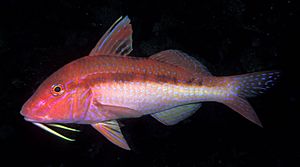Blue-striped mullet facts for kids
Quick facts for kids Blue-striped mullet |
|
|---|---|
 |
|
| Conservation status | |
| Scientific classification | |
| Synonyms | |
|
The Upeneichthys lineatus, also known as the blue-lined goatfish, is a type of fish found in the ocean. It belongs to the Mullidae family, which are often called goatfish. This fish lives along the Pacific coast of Australia. You can find it in calm areas where the bottom is rocky or sandy. It usually lives in water from 5 to 100 meters (about 16 to 328 feet) deep. This fish can grow up to 40 centimeters (about 16 inches) long. It is also important for fishing.
What Does the Blue-Lined Goatfish Look Like?
The blue-lined goatfish has a small mouth with soft lips. Each jaw has a single row of cone-shaped teeth. Like other goatfish, it has two fleshy feelers, called barbels, on its chin. These barbels help it find food.
The fish can be many different colors, from pale cream to a deep red. It often has blue and gold lines on its face. You might also see thin yellow lines and blue dots along its sides and tail. It has a clear stripe along its middle. Its top (dorsal) and bottom (anal) fins have yellow stripes. This fish can grow to about 31 centimeters (12 inches) long. It has 9 stiff spines and 8 soft rays in its dorsal fins. Its anal fin has one spine and 6 rays.
Where Does the Blue-Lined Goatfish Live?
The blue-lined goatfish lives only in the warmer waters off eastern and southeastern Australia. Its northern limit is near Fraser Island, Queensland. It lives south to Tasmania and west to Lakes Entrance, Victoria. This means it is found only in this specific part of the world.
Habitat and Life Cycle
The blue-lined goatfish prefers sandy areas in calm waters. These places include bays and harbors. It uses its special feelers (barbels) to search for food in the sand. It can live on different types of ocean bottoms, from smooth sand to areas with rocks and shells.
These fish often swim in small groups, looking for food on the seabed. They can be found at depths from 5 to 200 meters (about 16 to 656 feet). Their teeth are fine, meaning they don't have strong crushing teeth. They eat small molluscs, crustaceans (like crabs or shrimp), echinoderms (like sea urchins), and other small fish. They also eat larger, soft-bodied animals, such as polychaetes (a type of worm).
Blue-lined goatfish have separate male and female fish. They reproduce by releasing their eggs and sperm into the water. This happens above the ocean bottom. Both the eggs and the young fish (larvae) float freely in the water.


